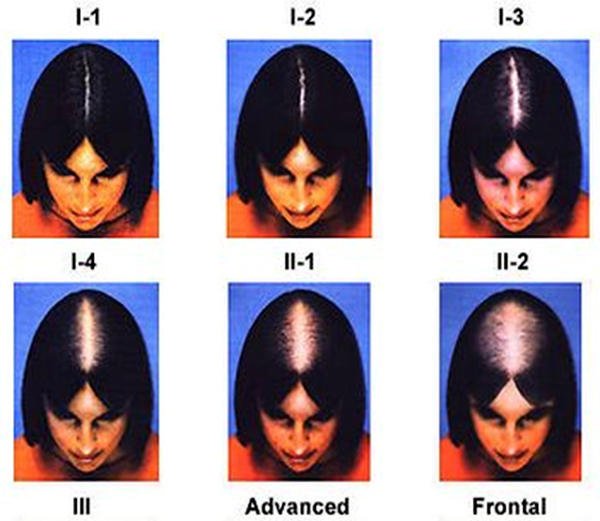The most frequent cause of hair loss in women is female pattern baldness or diffuse alopecia. IML has non-surgical treatments available to its patients for diffuse female alopecia.
- What is female pattern hair loss?
- Differential diagnosis in diffuse female alopecia
- Non-surgical treatment for diffuse female alopecia
- Session timetable for Female Pattern Alopecia Combined Protocol
1. What is female pattern hair loss?
This female pattern hair loss is characterised by:
- Diffuse hair loss on the central hairline
- Maintaining a line of hair in the frontal area
- Thinning of the hair calibre
- High rate of hair in the telogen stage (involutional) and anagen (growth)
- Increase in fibrous stele with fibrovascular serpentines
- There is an alteration in apoptosis regulation

Ludwig scale. Degrees of evolution of diffuse female alopecia
In 50% of pattern female diffuse alopecia, there is no associated hyper-androgynism and in general terms it is caused by hereditary factors.
Diffuse female pattern alopecia is an aesthetic problem which is more and more frequent in women. In the majority of cases it causes emotional disorders that can derive in anxiety and depression.
2. Differential diagnosis in diffuse female alopecia
The pathogeny of female pattern diffuse alopecia is still unknown, although it has been shown that it responds to certain pharmacological and local treatments.
Differential diagnosis is essential to choose the most appropriate treatment, with other causes of female alopecia, such as:
- Cicatricial alopecia
- Diffuse alopecia areata
- Traumatic alopecia due to surgery
- Traction alopecia
- Alopecia due to vitamin D or iron deficiency
- Polycystic ovary syndrome
- Thyroid disease
- Telogen effluvium
- Stress

Differential diagnosis is fundamental for efficient treatment of alopecia
Blood work
In order to act on the focus of diffuse alopecia, full blood work must be conducted, studying the following parameters:
- Biochemistry (nutritional):
- Iron
- Ferritin
- Total iron fixation capability
- Vitamin D
- Endocrinological (hormonal):
- Testosterone
- Oestrogens
- Prolactin
- THS
- T4
- DHEA
- Immunological
- C-reactive protein
- Antinuclear antibodies
3. Non-surgical treatment for diffuse female alopecia
In our Medical Centre, the basic treatment of diffuse female alopecia can be associated or not to an oral pharmacological treatment and is based on four points:
- LLLT (Low Level Laser Therapy)
- Growth factors
- Capillary mesotherapy
- Capillary carboxytherapy
These treatments are compatible and coadjutant. They can produce rapid visible improvement, given that the patient notices the slowing down of hair loss. Furthermore, they will perceive more hair density and vitality. However, the level of improvement as far as hair calibre is observed over a period of approximately 6 months.
1. LLLT. Low Level Laser Therapy
LLLT consists of the application of low frequency light on the scalp, avoiding the thermal effect. This photo stimulation generates the following benefits:
- Increased cell proliferation and migration
- Increased growth factor production
- Improved microcirculation
- Tissue oxygenation
Photo stimulation increases cell proliferation and migration, as well as growth factor production, inducing hair re-entry into the anagen stage with foreseen entry into the catagen stage.
The wavelengths applied are between 635 and 655 nm and can be coherent light (laser) or non-coherent light (LED).
Number of sessions: 10 to 20.

Non-surgical treatments of diffuse alopecia reduce the rhythm of hair loss
2. Growth factors
The growth factors stimulate the increase in cellular metabolism, such as multiplication and migration of fibroblasts, resulting in collagen synthesis. Stem cells are also activated in the treatment area. All of this produces improvements in the hair follicles.
On a blood level, different growth factors are found:
- PDGF (Derived Growth Factor). It acts on the fibroblasts, bone cells and myoblasts, making it a broadly specific factor. This factor has great influence on the fibroblasts, given that it stimulates cell multiplication and its chemotactic or magnet effect. It also stimulates the production of collagen fibres on an extracellular substance level.
- VEGF (Vascular Endothelial Growth Factor). It performs an important mitogenetic or multiplication function of the vascular endothelial cells, which gives it a high angiogenesis capacity.
- TGF-β1 and TGF-β2 (Transforming Growth Factor Beta). This factors are closely bound to connective tissue repair. They perform an accelerator effect on collagen production.
- IGF I and II (Insulin-like Growth Factor 1 and 2). They possess chemotactic activity on the fibroblasts and precursor cells.
- FGF a and FGF b (acidic and basic Fibroblast Growth Factor). These are growth factors associated with injury repair, with effect on the endothelial cells and vascular proliferation, fibroblasts, keratinocytes, myoblasts and others.
- EGF (Epidermal Growth Factor). They have and important effect on stimulating division and multiplication of the fibroblasts and keratinocytes. They also stimulate epithelial cell migration and division and increase protein synthesis, such as fibronectin.
The growth factors are obtained from the patient's own blood, which undergoes a centrifugation process through which the different blood fractions are extracted. Growth factors contains the highest amount of growth factors. This treatment is infiltrated into the scalp, where the following effects are produced:
- Macrophage chemotaxis
- Stem cell chemotaxis and promitotic, fibroblasts and osteoblasts
- Extracellular matrix regeneration (collagen)
- Angiogenesis effect, that is, stimulation of new microvascular buds and extracellular matrix formation
Number of sessions: 3 sessions, every 2 or 3 weeks.
3. Capillary mesotherapy
Capillary mesotherapy consists of the application of substance for alopecia through micro-punctures in the scalp, with an average density of 0.2 ml per puncture, using a total amount of 5 to 10 ml per session, depending on the severity and extension requiring treatment.
The infiltrated substances include:
- Minerals and coenzymes:
- Calcium chloride
- Magnesium sulfate
- Potassium chloride
- Sodium chloride
- Sodium phosphate
- TPP (Cocarboxylase)
- Co A (Coenzyme A)
- FAD (Flavin Adenine Dinucleotide Disodium)
- NAD (Nicotinamide Adenine Dinucleotide)
- Vitamins:
- Vitamin B10 (Aminobenzoic acid)
- Vitamin B7 (Biotin)
- Vitamin B5 (Pantothenic acid)
- Vitamin B12 (Cyanocobalamin)
- Vitamin B9 (Folic acid)
- Vitamin B8 (Inositol)
- Vitamin K
- Vitamin B3 (Niacinamide)
- Vitamin B6 (Pyridoxine)
- Vitamin B2 (Riboflavin)
- Vitamin B1 (Thiamine)
- Vitamin E (Tocopherol)
- Amino Acids
- Alanine
- Aminobutyric acid
- Arginine
- Asparagin
- Aspartic acid
- Cystine
- Glutamic acid
- Glutamine
- Glycine
- Histidine
- Hydroxyproline
- Isoleucine
- Leucine
- Lysin
- Methionine
- Phenylalanine
- Proline
- Serine
- Taurine
- Threonine
- Tryptophan
- Tyrosine
- Valine
- Nucleic acids
- Adenosine
- Cytosine
- Guanosine
- Thymine
- Peptides
- Decapeptide-4
- Acetyl decapeptide-3
- Oligopeptide-41
- Tripeptide-1
Number of sessions: 4 to 10.
4. Capillary carboxytherapy
Subcutaneous infiltration of CO2 into the scalp produces the following benefits:
- Improved blood microcirculation in the region
- Neoangiogenesis stimulation or generation of new blood vessels
- Increase in endothelial growth factors
- Dermal stimulation
- Increase in collagen synthesis
Capillary carboxytherapy, therefore, improves cutaneous metabolism rate and causes stimulation of the hair bulb.
The dose applied at IML is 5 ml CO2 per puncture.
Number of sessions: 4 to 10.
The IML Combined Protocol sessions for female pattern alopecia treatment can be planned as follows:
| Week |
Treatment |
Treatment |
| 1 |
Growth F. |
LLLT |
| 2 |
Meso |
LLLT |
| 3 |
Carbo |
LLLT |
| 4 |
Growth F. |
LLLT |
| 5 |
Meso |
LLLT |
| 6 |
Carbo |
LLLT |
| 7 |
Meso |
LLLT |
| 8 |
Growth F. |
LLLT |
| 9 |
LLLT |
| 10 |
LLLT |


